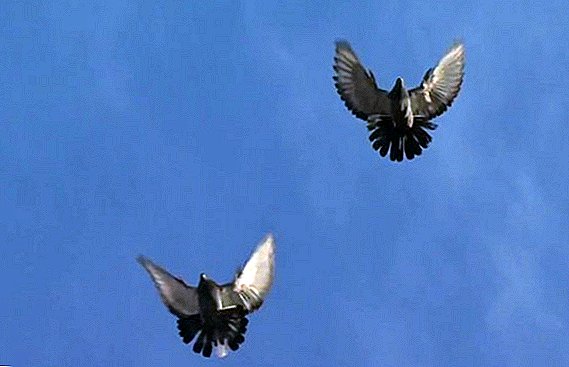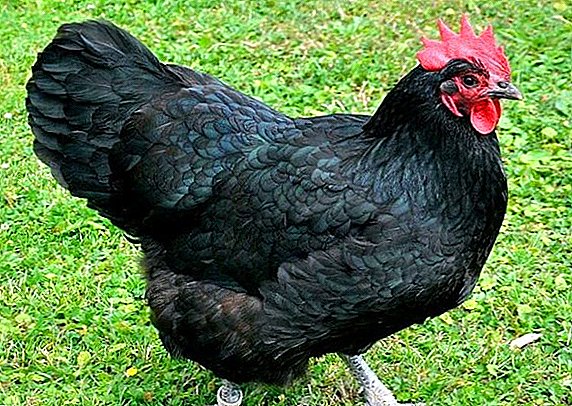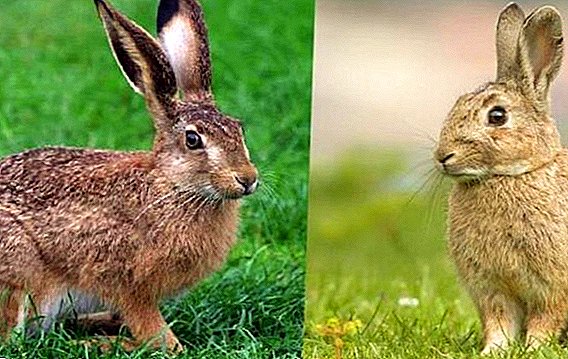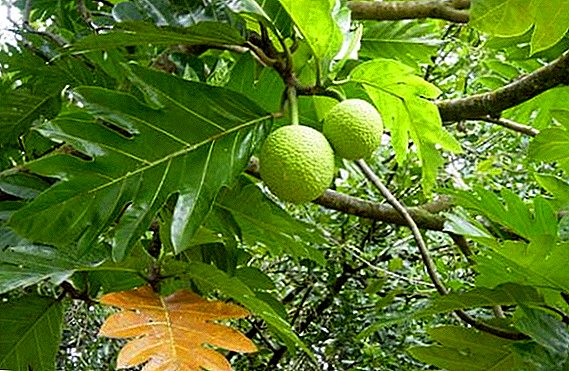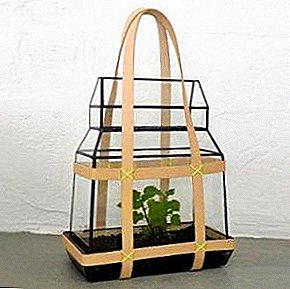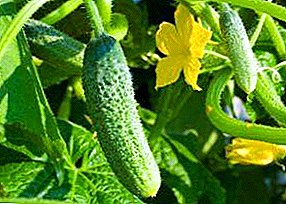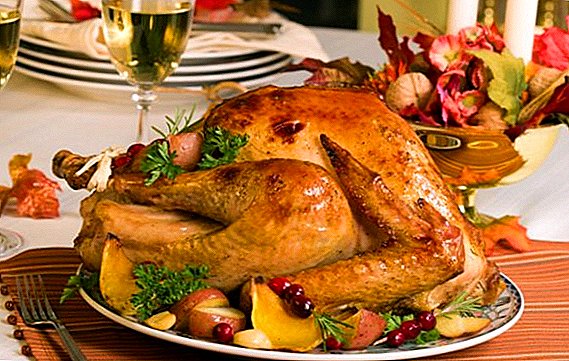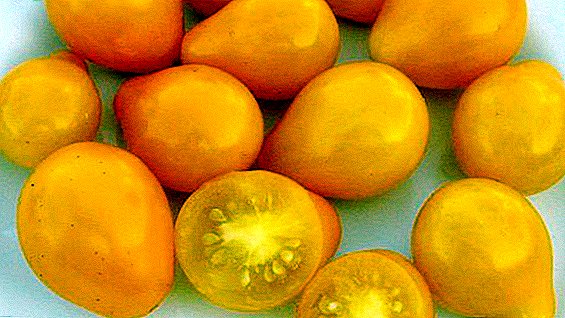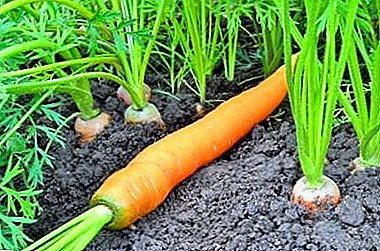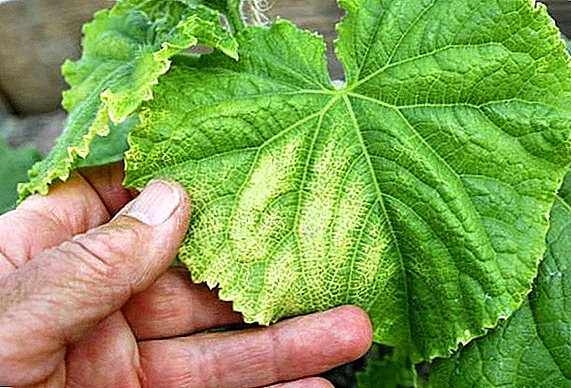 When the cucumber leaves, just yesterday luxurious and green, suddenly began to turn yellow, you need to take urgent measures to save the plant. This is a symptom of a serious illness, so it can not be ignored. Consider what caused the undesirable changes in the green color of the leaf cover of cucumbers and how to deal with it.
When the cucumber leaves, just yesterday luxurious and green, suddenly began to turn yellow, you need to take urgent measures to save the plant. This is a symptom of a serious illness, so it can not be ignored. Consider what caused the undesirable changes in the green color of the leaf cover of cucumbers and how to deal with it.
The main causes of yellowing leaves
There are several reasons for yellowing of cucumber leaves, which can be determined by taking into account the place where plants are grown (open ground, greenhouse, greenhouse), the shape and location of necrosis spots on a leaf plate. The most common cause is noncompliance with cultivation farming practices or mistakes in plant care. Sometimes yellowness on leaf plates indicates an acute nutrient deficiency or the development of infectious diseases. 
Wrong watering
Cucumbers are very fond of water, the lack of moisture causes dehydration of plants and the first signal about drying of the root zone may be yellowing of the leaves.
For cucumbers, the correct irrigation technique is also important.Watering should be regular (ideally nightly) and in sufficient quantity.
It is easy to check if your cucumbers have enough moisture: if the bed soil is wet at a depth of more than 15 cm, everything is in order and there is enough moisture.
Important! Too much water for cucumber is also not always good, especially in cold weather. Waterlogging in this case can cause rotting of the roots and fruit ovaries. If the air temperature drops below 10°C, watering the beds should be temporarily suspended.
Fertilizer errors
The rapid growth of aboveground and underground parts can deplete plants and cause nutrient deficiencies. This shortage causes yellowing on the leaves. In the process of growing cucumbers need to be fed several times with fertilizers, which contain a sufficient amount of nitrogen and other useful substances. 
Familiarize yourself with the nuances of growing cucumbers in the open field, greenhouse, buckets, barrel, bags, on the windowsill, balcony, using hydroponics.
Low temperatures
Cucumbers are tropical plants and need a humid and very warm climate. For their successful cultivation you need full compliance with the optimum temperature. It is known that cucumber ovaries gain mass only at night, and if the air temperature drops below 10 ° C, the growth of fruits stops and the leaves turn yellow. This is a normal reaction of a tropical plant to low temperatures.
Burns
Thermal burns occur after watering cucumbers in hot weather and look like red or yellow-brown spots. The drops of water remaining on the leaves, when exposed to the rays of the sun, act as an air lens, which causes burns. That is why it is recommended to water cucumbers only in the evening (after 16 hours) and always at the root. 
Pests and diseases
In diseased plants often withered or yellowed foliage is observed - the cause of this is fungal and viral diseases. The most common disease among pumpkin crops, to which cucumbers belong, is a defeat by Fusarium.
Find out what is dangerous Fusarium and how to deal with this disease of cucumbers.
Root damage
Roots can be damaged by insect pests, or the stormy activities of moles, mice or shrews. Also, plant roots can be damaged during weed control (weeding, loosening). Disruption of the normal development of the root system can cause the appearance of yellow leaves.
Did you know? The great commander and at the same time French emperor Napoleon Bonaparte loved and appreciated cucumbers. Being on hikes for a long time, he felt a lack of these vegetables, and therefore they were promised a huge reward (equal to about 250,000 modern dollars) to a person who would offer an effective way to keep cucumbers fresh during the winter. History is silent if anyone has received this award.

What to do and how to feed: understand more
Before you begin to take steps to save the yellowing cucumber lash, you need to carefully understand the reasons.
Yellowing and twisting
Twisted and yellow cucumber leaves are an alarming sign that indicates growing problems:
- Lack of nutrients. If, when visually inspecting the beds, it was noticed that the leaf plates lost their brightness and their edges began to wrap down - perhaps the plants lack nitrogen fertilizers. If it can be seen that the paper has grown in length, but has not increased at all in width, the plantings need complex feeding.
- The scourge of cucumbers is powdery mildew. Usually pumpkin and melon crops are exposed to this disease in late June - early July. A diseased cucumber plant has yellow and twisted leaf plates. To prevent this, or to cure the already diseased plantings, treatment is carried out with a solution of Bordeaux liquids (one percent) or other chemical preparations. If plantings are in a greenhouse or greenhouse, regular ventilation and drafts are necessary.
- Insect pests. If the leaves lose their brightness, turn yellow and curl into a tube, it is possible that harmful insects have settled on the cucumbers. Turn the leaf blade and inspect it. Most likely, it will be covered with a fine aphids or spider mites. You can fight this scourge with the help of chemicals (insecticides or acaricides). It is necessary to spray the affected plants with special preparations, and after 10-12 days, repeat the treatment to fix the result.
- Viral diseases. If agrotechnical cultivation is observed (temperature, feeding, treatment for diseases and pests), but deformed or yellowed leaves still appear on cucumber plantations, this indicates that the disease is viral in nature. Such a plant should be removed from the garden immediately, taken out of the garden and destroyed with the help of fire. These measures will not allow the viral disease to spread to all plantings.
- Sunburn or lack of heat. Yellowing cucumber leaves often signal non-compliance with the temperature regime of growing the culture. Low night or daytime temperatures, or the contact of the leaf cover of plants with the cold walls of the greenhouse, cause the leaves to curl. This feature should be taken into account when planting young plants in greenhouses or greenhouses, and not plant them too close to the walls of a temporary shelter.
- Dry air As mentioned above, the cucumber loves moist and warm air. If there is not enough moisture in the air and the plant suffers "water hunger", then to reduce the leaf surface, from which moisture will evaporate, the wide leaf plate will be rolled up into a tube. This problem is easy to fix with plenty of watering.
Learn how to deal with powdery mildew on cucumbers.


Did you know? The ancient Roman emperor Tiberius was the initiator and ancestor of the greenhouse economy. Based on his desires and needs, his subjects invented and lined up glazed rooms, where cucumbers were grown for the emperor during the cold season.
Yellowing of the lower leaves
Usually, this trouble happens to the leaves, located near the ground, as in the event of unfavorable conditions for growth, the plant sends all the nutrients to the upper part, where the growing point and fruit ovaries are located. Therefore, the appearance of yellowing lower leaves is not always caused by a disease. Sometimes it is a natural process of vegetation - the leaves turn yellow and soon fall off when the plant tries to get rid of excess leaf mass (ballast).  The reasons for this phenomenon:
The reasons for this phenomenon:
- Little light. A cucumber has one large leaf in each bosom - as a result, on a cucumber plant from 40 to 70 leaves. If such lush plants are planted in rows, this creates excessive tightness and shading. The lower part of the plant does not receive sufficient sunlight, so cucumbers discard the lower leaves that shade them.
- Waterlogging or drought. Both of these causes can lead to yellowing and leaf fall.
- Cold air and soil. Hypothermia causes loss of leaf color in the lower part of the plant.
- Lack of nutrients. A change in color in the lower part of the leaf cover may indicate a lack of nutrition (magnesium, potassium or phosphorus). This deficiency can be filled, but not by the introduction of any one mineral substance, but by a complete complex feeding. If you try to bring these substances separately, you can do it incorrectly (not enough to make or with an excess).
- Fungal diseases. The foliage below is the first to be hit by fungal diseases (fusarium, pythiasis, blight). This is facilitated by direct contact with the soil, an overabundance of moisture, shading. Diseased plants lose turgor, become lethargic, thin.

Important! Infected leaf plates need to be torn off, taken out of the greenhouse or garden and destroyed with fire. This will stop the spread of the disease throughout the greenhouse or cucumber beds. It must be remembered that fungal diseases develop very quickly. - if you do not take urgent measures, then within two or three days the spores of the fungus can destroy the entire cucumber plantation.
Yellowing around the edges
When the gardener notices that the edges of the leaves of the cucumber begin to turn yellow - you need to understand the reasons and urgently take measures to save the vegetable plantation.
- Fungal diseases. This form of leaf necrosis is characteristic of powdery mildew beginning on cucumbers. The combination of rainy cold weather and yellowing of the edges of the leaf cover requires urgent treatment of cucumbers with Bordeaux liquid (one-percent solution). Do not make the solution Bordeaux fluid more saturated, as this threatens the plants death (you can burn).
- Lack of moisture in the air and soil. These reasons can also provoke cucumbers to the appearance of yellowness and dried edges on the leaves.
- Lack of mineral nutrition, possibly potassium. If the edge of the cucumber leaves brightens with respect to the center of the leaf, this rim indicates the urgent need of the plant to conduct additional fertilizing, preferably complex.

Yellowing of ovaries and leaves
A sharp drop between heat and a decrease in temperature (usually in conjunction with rains) provokes the appearance of fungal diseases in vegetable crops. In this case, it is necessary to immediately treat cucumber plantations with chemical ("Kvadris", "Topaz", "Tiovit jet") or biological preparations.
Read more about why the cucumber ovaries turn yellow in the greenhouse.
Absolutely harmless, but effective infusions for processing cucumber lashes: whey with sugar for sticking (1 teaspoon of sugar is taken for 1 liter of serum), garlic water (100 g of milled garlic for 2 l of water, mix and leave to infuse for 24 hours) .
If yellowness appeared not only in the lower part of the plant, but also captured the upper leaf plates - it is time to save the plant. Ignoring these signals, the gardener may be left without a crop.
Did you know? Cucumber firmly entered the culinary traditions of mankind since the time of the Mesopotamian civilization - more than four and a half thousand years ago. The first began to engage in the cultivation of cucumbers as a cultivated plant residents of India.
 The reasons for this:
The reasons for this:- Lack of lighting - very often for this reason, the leaves and cucumber ovaries turn yellow. The fact that there is not enough light for the lower part of the plant is not so critical, however, if the upper, fruiting part of the plant experiences a lack of sunlight, you need to quickly find a way out. If the culture is grown in greenhouse conditions, then, if necessary, wash the contaminated walls and ceiling of the greenhouse. If the problem is in constant cloudy weather - the landing should be done artificially with the help of fitolamps (from 4 to 12 hours per day).
- Cold air and ground. The low temperature contributes to the yellowing and death of cucumber ovaries and leaf cover. In greenhouse cultivation, the situation can be corrected by raising the air temperature using the heating system to the desired temperature. If there is warm air in the greenhouse, then the temperature of the soil, respectively, increases.
- Lack of mineral nutrition. Watering not only gives the plants the necessary moisture, but also washes away minerals (nitrogen, potassium) from the soil. Therefore, they should be placed under the plant root several times per season. This problem is solved by the introduction of complex mineral fertilization.
VIDEO: WHY DO YELLOWS AND DON'T GROW BUNCHES ON CUCUMANS?
The best air temperature for growing cucumbers
Prior to fruiting:
- in sunny weather - from 22 to 24 ° C;
- in the absence of sunlight - from 20 to 22 ° C;
- at night - from 17 to 18 ° C.
- in the daytime, in sunny weather - from 23 to 26 ° C;
- in cloudy weather - from 21 to 23 ° C;
- at night - from 18 to 20 ° C.
Yellowing stained
If yellow spots appear on the green leaf plate, it is most likely that cucumbers are affected by one of the fungal diseases.
- Anthracnose - the disease can be identified by the appearance of round red or brown spots on the leaf plate. The edges of these spots will not have clear contours, rather blurry outlines are inherent in them. When foggy or rainy weather, as well as high humidity in the greenhouse, pale pink pads will appear on the spots. The diagnosis can be confirmed by elongated black strokes - sores located on cucumber lashes.
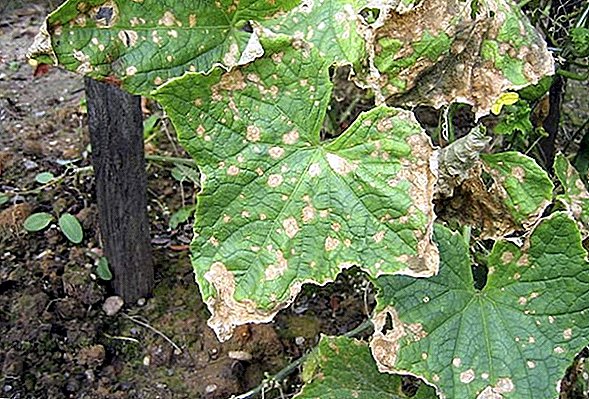 To treat diseased cucumbers can be done with the treatment of plantings with one-percent suspension of colloidal sulfur. After 10-14 days, one more treatment is necessary, but this time it is necessary to apply Bordeaux liquid (one percent solution). Ulcers on cucumber lashes and other visually observed places of a fungus lesion should be treated with a solution of water and copper sulphate (0.5%), and then powdered with powdered charcoal.
To treat diseased cucumbers can be done with the treatment of plantings with one-percent suspension of colloidal sulfur. After 10-14 days, one more treatment is necessary, but this time it is necessary to apply Bordeaux liquid (one percent solution). Ulcers on cucumber lashes and other visually observed places of a fungus lesion should be treated with a solution of water and copper sulphate (0.5%), and then powdered with powdered charcoal. - Downy mildew - is determined by the presence of yellow round spots on the surface of the sheet plate and white-gray bloom in the lower part of the sheet. On the plant affected by this disease, the leaf cover becomes dirty brown, dries and falls. Control measures: diseased cucumber plantations should not be watered for seven days, immediately spray with Oksih (10 g of substance per 5 liters of water). If downy mildew appeared on young plants that have not yet formed the ovary, you can apply the treatment with the drug "Rizoplan" (1 tablespoon of the drug per 5 liters of water).
 All treatments can be carried out only in the evening when the air temperature drops. But the measures described can only halt the rapid spread of the disease. Old cucumber lashes in autumn must be burned, as they are a source of mushroom spores. If you do not destroy the spores by fire, the fungal disease will overwinter on plant residues and in the next garden season will begin to parasitize on new vegetable plantings. It is advisable not to sow cucumbers on this site for the next few years, as well as any melons or pumpkin crops.
All treatments can be carried out only in the evening when the air temperature drops. But the measures described can only halt the rapid spread of the disease. Old cucumber lashes in autumn must be burned, as they are a source of mushroom spores. If you do not destroy the spores by fire, the fungal disease will overwinter on plant residues and in the next garden season will begin to parasitize on new vegetable plantings. It is advisable not to sow cucumbers on this site for the next few years, as well as any melons or pumpkin crops.
Did you know? The longest cucumber in the world has grown a gardener from England Alf Cobb. The length of an unusual cucumber reached 91 cm 7 mm. The record-setting cucumber was presented by a gardener who raised him at an agricultural exhibition in the city of Bath, which is located in the south-west of England.
Features care for cucumbers with yellowed leaves
Consider the causes of yellowing of cucumber leaves on plants planted in open ground. The reasons may be different. In order for cucumber lashes and leaves to be powerful and healthy, it is advisable to adhere to the proper agricultural practices in growing the culture.
In the open ground
- Do not leave plants without shelter in cold weather. If the air temperature has dropped below 15 ° C, cover your plantings with agrofiber or place them over the rows of an arc and throw plastic wrap over them. In case of using polyethylene film during the day, do not forget to leave the ends of the temporary shelter open - this is necessary to control the air temperature in the greenhouse and ventilate the beds with drafts.
- Water moderately. When the cucumber leaf cover turns yellow due to a lack of moisture, begin to regularly supply water to the roots of the plants, and the yellowing will stop. If the reason is an overabundance of water in the soil - immediately stop watering for a while, loosen the soil, combined with the introduction of sand and wood ash into the root zone.If a black leg fungal disease is found on cucumber plantations, then after carrying out all the above procedures, the soil of the bed is slightly moistened with a pale pink manganese solution.
- Give the plants food. Carry out regular feeding (mineral and complex), relying on the agrotechnology of cultivation of this culture. Yellow leaves of a cucumber can signal that the plant is on a “starvation”.
- Conducting treatments from pests and diseases. A gardener should visually inspect plantings two or three times a week so as not to miss the initial stage of development of diseases or pest invasions.
- Do not fertilize the leaves and water cucumber plantations in the daytime. This will help eliminate sunburn on the leaves.


In the greenhouse or on the balcony
It is the non-observance of the agrotechnical cultivation (temperature conditions, fertilizing, moisture supply, treatments for diseases and pests) that causes plant diseases in the greenhouse. The very first signal that the plants feel bad may be yellowing of the leaf cover.
Those who wish to grow a good crop of cucumbers in the greenhouse, it is useful to learn how to water cucumbers, which varieties are better to plant than to feed them and whether to tie up.
Cucumbers in the greenhouse
To restore cucumbers to health, you need to adhere to the following rules for growing:
- Follow the rules of watering. When cucumbers bloom and start fruiting, they need to be watered three times a week (in two or three days) or even more often (in a day). For every square meter of cucumber beds make 10 liters of water. Of course, in the heat to water cucumbers should be more abundant (15 liters per square meter). In the absence of the sun or in rainy weather, it is necessary to water cucumber plantation less often, perhaps once a week. It is quite easy to determine if a cucumber bed needs moisture at the moment: if the soil is wet at a depth of 10-15 cm, watering can be postponed for several days.
- Observe the temperature chart. The above is the optimal temperature for growing cucumbers. Vegetable growers must adhere to this temperature chart.
- Adjust the air temperature using open or closed doorways and window transoms. Heat stress is absolutely unacceptable when growing cucumbers.
- Arrange drafts. To avoid the outbreak of fungal diseases in the greenhouse, it is necessary to conduct forced ventilation of the room. This gardener will help drafts. To get a draft, you need to open the frames or openings at opposite ends of the greenhouse or temporary shelter. The movement of air dries the leaf mass from excessive moisture, thereby preventing the development of fungal diseases (downy mildew and others).
- Do not forget to carry out regular feeding. If the yellowing of the leaf mass does not indicate infection with spores of fungal diseases, then after the dressings, the leaves will again turn green.
- Treat cucumbers for diseases and leaf-sucking insects. Spores of fungi die after treatment with Bordeaux liquid (one percent solution), and with aphids on cucumbers you can cope with a solution of a nitroammofoski (6 tablespoons per 20 liters of water). Spider mite does not tolerate the neighborhood with a solution of colloidal sulfur. On 80 g of colloidal sulfur 10 liters of water are taken and thoroughly mixed. This solution is sprayed cucumber planting on the sheet.
- Avoid density in the greenhouse. Excessive closeness of plants in the beds leads to yellowing of the lower leaves. The lower part of the plants does not see the sun, so the leaves turn yellow and die. The crowding also contributes to outbreaks and the rapid development of fungal diseases.


Did you know? The small Ukrainian city of Nizhyn has been famous for its tasty cucumbers for hundreds of years. The variety of cucumbers grown there is called "Nezhinsky". On the station square of this city a monument to Nezhin cucumber is installed.
Cucumbers on the balcony
If cucumber leaves have started to turn yellow in plants planted in pots, it is necessary to determine the cause and act accordingly:
- Poor enough pots or drawers. If the young cucumbers begin to turn yellow leaves, most likely their root system has become cramped in the containers in which it is planted. The plant needs to be transplanted by transferring to a larger pot, then its root system will be able to develop further and it will feel good.
- Too much moisture in the air. In order for cucumbers not to get sick with one of the fungal diseases, you need to air the loggia or balcony regularly.
- Too much or too little water when watering - this is also one of the reasons for the yellowing of the leaves of the cucumber.
- Need for feedings. It must be remembered that the growing season of cucumber in limited capacities means that the plant eventually draws out all the useful substances from the soil and in the future it should be regularly fed. Young cucumber seedlings are fed for the first time after the appearance of two or four true leaves. To do this, use complex nitrogen fertilizer, which must be used strictly according to the attached instructions. Cucumbers growing in containers cannot be fed with natural organic fertilizers.


Yellowing Prevention
In order to prevent the disease of the cucumber plantation, we must adhere to several rules:
- observe the recommended distance (20-25 cm) between plants when disembarking to a permanent place;
- provide good lighting;
- adhere to the optimal temperature conditions (to avoid "thermal shock" or overcooling);
- not to turn the garden "into a marsh", but also not to keep the plants on a dry ration;
- when growing greenhouse, ventilate the room and create drafts;
- time to handle planting from diseases and harmful insects;
- carry out complex and mineral supplements regularly;
- saturate the soil with oxygen using loosening;
- tie up the plants, preventing contact of cucumber lashes with the soil;
- regulate the load of the fruits;
- time to harvest.
Did you know? Only less than 5% of the total mass of cucumber accounts for nutrients and minerals, while the remaining 95% of the vegetable mass is water.In order to prevent yellowing of cucumber leaves, it is possible to treat cucumber plantations with biologically active, but harmless to human health solutions. Here are some recipes:
Recipe number 1
A solution of milk and soap - pour a liter of milk into an empty ten-liter bucket, add 20 g of grated household soap and 30 drops of iodine there. Top up the bucket to the top with lukewarm, clear water.  Mix the contents of the container until the soap is completely dissolved in water. This tool can be used to process cucumber plantations on a leaf every decade. You can start using this tool as soon as the cucumber throws out two pairs of true (not cotyledon) leaves!
Mix the contents of the container until the soap is completely dissolved in water. This tool can be used to process cucumber plantations on a leaf every decade. You can start using this tool as soon as the cucumber throws out two pairs of true (not cotyledon) leaves!
Among folk remedies for feeding cucumbers iodine and yeast are effective.
Recipe number 2
Black bread and iodine - one loaf of black bread is poured with 10 liters of water for several hours. After the bread swells, it is kneaded by hand in water and the contents of one bottle of iodine are added to the mixture. The resulting concentrate is used only in a diluted state. For the treatment of plants, one liter of concentrated solution is taken and mixed with 10 liters of pure water. This solution must be processed cucumbers on a sheet every 14 days. Store the remaining solution in a dark and cool place.
Video: Bread dressing with iodine for cucumbers
Recipe number 3
Onion peel - for the preparation of the infusion you need a bank of husk with a capacity of 0.7 liters. This amount of onion peel is poured with ten liters of water, the mixture is brought to a boil, closed with a lid and left to stand overnight. In the morning, the cooled and strained concentrated solution is ready for use. For spraying concentrate diluted, for every 2.5 liters of concentrate take 10 liters of pure water. The solution is sprayed on cucumbers sheet. You can use this tool every week.  Recipe number 4
Recipe number 4
Manganese solution - as soon as the first yellowed leaves are found on the cucumbers, they need to be treated with a light pink solution of potassium permanganate and water. This will stop the development of mushroom spores and disinfect the surface of leaflets.
Cucumbers - quite capricious in growing vegetable culture. However, adhering to the proper agricultural practices, any gardener can annually pamper his family with fragrant and pimply green cucumbers, at the same time filling the cellar with vegetable blanks for the winter. First of all, you need to carefully monitor the plantings, and noticing the problem - immediately begin to search for a solution.


 To treat diseased cucumbers can be done with the treatment of plantings with one-percent suspension of colloidal sulfur. After 10-14 days, one more treatment is necessary, but this time it is necessary to apply Bordeaux liquid (one percent solution). Ulcers on cucumber lashes and other visually observed places of a fungus lesion should be treated with a solution of water and copper sulphate (0.5%), and then powdered with powdered charcoal.
To treat diseased cucumbers can be done with the treatment of plantings with one-percent suspension of colloidal sulfur. After 10-14 days, one more treatment is necessary, but this time it is necessary to apply Bordeaux liquid (one percent solution). Ulcers on cucumber lashes and other visually observed places of a fungus lesion should be treated with a solution of water and copper sulphate (0.5%), and then powdered with powdered charcoal. All treatments can be carried out only in the evening when the air temperature drops. But the measures described can only halt the rapid spread of the disease. Old cucumber lashes in autumn must be burned, as they are a source of mushroom spores. If you do not destroy the spores by fire, the fungal disease will overwinter on plant residues and in the next garden season will begin to parasitize on new vegetable plantings. It is advisable not to sow cucumbers on this site for the next few years, as well as any melons or pumpkin crops.
All treatments can be carried out only in the evening when the air temperature drops. But the measures described can only halt the rapid spread of the disease. Old cucumber lashes in autumn must be burned, as they are a source of mushroom spores. If you do not destroy the spores by fire, the fungal disease will overwinter on plant residues and in the next garden season will begin to parasitize on new vegetable plantings. It is advisable not to sow cucumbers on this site for the next few years, as well as any melons or pumpkin crops.